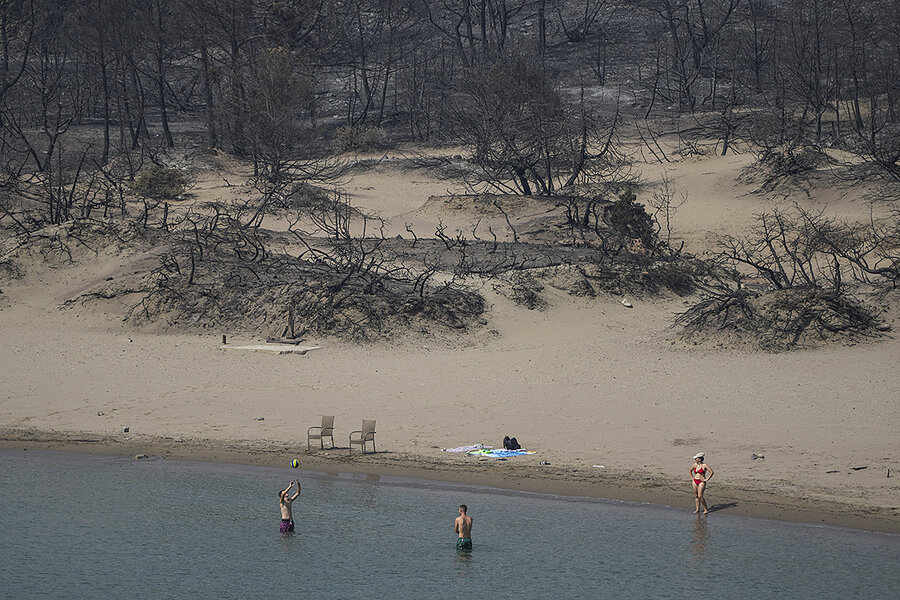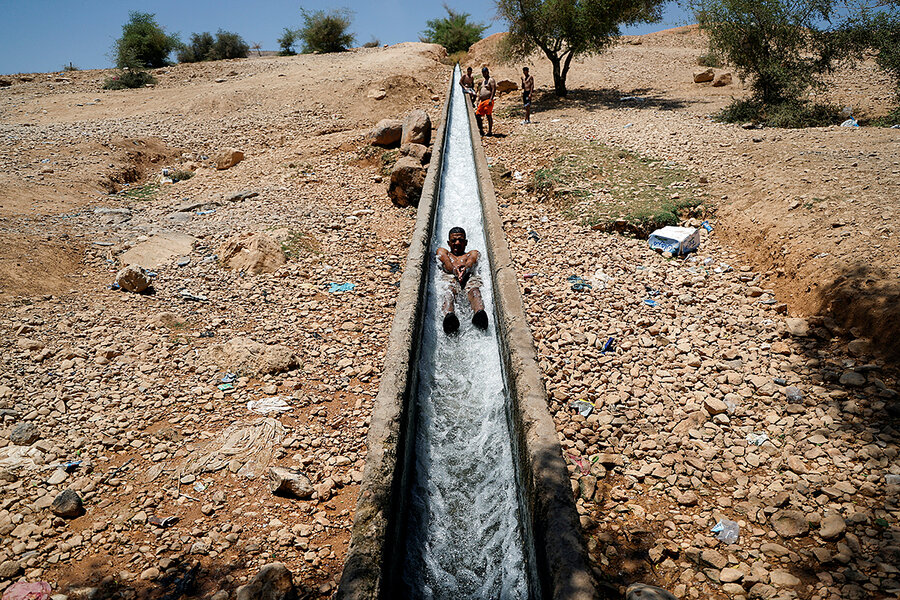Cruel summer: Will 2023 mark a tipping point for climate change?
As record heat was just starting to sweep across the Northern Hemisphere this summer, Nikolaos Mihalopoulos was clearing the overgrowth in his garden of olive and citrus trees in the Peloponnese region of Greece.
His village home had been basking in the rainy month of June, and the grasses were growing to over 3 feet, he says. In early July, he had to clear the overgrowth yet again.
Then, like so many other regions throughout northern Africa, Asia, Europe, and North America, an unprecedented heat wave began to sweep over Greece, pushing temperatures up to a record 116 degrees Fahrenheit in the Peloponnese. June’s verdant landscapes quickly dried to a desiccated yellow – setting the stage for a conflagration of wildfires that grabbed global headlines in July.
Why We Wrote This
A story focused onA summer marked by the hottest temperatures on record has raised fundamental questions about how to manage climate crises – and take responsibility for doing so.
Wildfires are relatively common this time of year, but high temperatures and strong winds turned them into heat wave-inflicted infernos racing through dried-out landscapes. Almost 20,000 tourists needed to be rescued on the island of Rhodes – an operation Greek officials called the country’s largest evacuation effort ever. Firefighting crews from all over Europe were brought in to battle the flames, even as the 2023 wildfires were spewing more carbon dioxide into the atmosphere in a week than Greece normally produces in a year.
“More and more people are now persuaded that there is a climate crisis,” says Dr. Mihalopoulos, research director at the Institute for Environmental Research and Sustainable Development at the National Observatory of Athens, which began meteorological observations in 1858. “I don’t know if they know the causes – this is a big question mark. But they know that something not normal is happening.”

Petros Giannakouris/AP
People play on Glystra Beach in front of a forest burnt by wildfires on the island of Rhodes, Greece, July 27, 2023.
Regardless of public attitudes, the changing climate is putting the country’s iconic olive oil production at risk. Tourism, which comprises nearly 20% of Greece’s economy, is also threatened. By necessity, most homes in large cities now have air conditioners, and about half in smaller towns and villages do as well. It has created a vicious circle that requires the production of even more carbon-emitting energy, while also taking up a greater share of household costs.
Discussions of climate change, in fact, have been happening for over 50 years. The long-term impact of carbon emissions and the resulting global greenhouse effects are both well-established and relatively simple scientific observations. Headlines over the past decade have reported other dangerous heat waves, massive wildfires, and patterns of unusually violent weather.
But the summer of 2023 has been especially and vividly cruel around the world in ways never seen before, possibly making it an inflection point, a proverbial tipping point that forces human beings to change.
“There is a greater sense of awareness, which is not the same as greater sense of urgency,” says Sam Fankhauser, professor of climate change economics and policy at the University of Oxford in England.
Something not normal is happening. July was the hottest month ever recorded, according to multiple weather agencies. Some climate scientists think it might even be the hottest month in the past 120,000 years, when measuring global averages. In its first week, July produced the three hottest single days ever recorded, according to the World Meteorological Organization. The hottest eight years on record, in fact, have all happened after 2015.
In the same way, ocean temperatures as a whole have never recorded temperatures as high as they are today. Weather buoys in and around the Florida Keys in late July measured waters topping 100 degrees Fahrenheit, the National Oceanic and Atmospheric Administration reported. That’s the temperature of an average hot tub.

Matthew Thayer/The Maui News/AP
The hall of the historic Waiola Church in Lahaina and nearby Lahaina Hongwanji Mission are engulfed in flames, Aug. 8, 2023, in Lahaina, Hawaii.
In the United States, at least 5,300 climate records around the country have been broken or equaled this summer, says Steven Rothstein, managing director of the Ceres Accelerator for Sustainable Capital Markets in Boston, which analyzes data from the National Oceanic and Atmospheric Administration. These include record-high temperatures during the day, record-high nighttime temperatures, the most consecutive days above 100 F, and other climate abnormalities.
In North America, hundreds of wildfires burned all summer across Canada. The smoke came billowing down into the U.S. from Minnesota all the way to the Northeast, driving Americans indoors to escape toxic air – with New York recording the worst air quality in the world. In the Pacific, deadly fires in Hawaii this week overwhelmed rescue services, killing several dozen and wiping out historic neighborhoods. Phone services – including 911 – went down, and there were widespread reports of people jumping into the ocean to escape the flames.
If the data on global warming may indeed shift public attitudes and policy decisions, it may be the “invisible hand” of global capitalism putting systematic pressure on modern economies that ultimately speeds up the transition to carbon-neutral energy sources, Mr. Rothstein says.

Ammar Awad/Reuters
Palestinian men cool off during a heat wave in al-Auja springs near Jericho in the Israeli-occupied West Bank, July 18, 2023.
“If you just look at the banking industry, there is more climate risk on the balance sheets of banks today ... than there was in 2008 because of subprime housing,” says Mr. Rothstein, whose company aims to transform the practices and policies that govern capital markets to reduce the economic risks of the climate crisis.
Insurance companies around the world are deciding to no longer cover certain regions – including the states of California and Florida – or certain businesses because of climate-related disasters. According to Ceres’ analysis of available data, there have been 357 natural disasters in the U.S. that had damages of more than $1 billion since 1980. They are now becoming more frequent.
In the 1980s, the time between billion-dollar disasters was an average of 82 days. In the years from 2017 to 2021, there was an average of only 18 days between billion-dollar disasters. All said, the total cost of these climate events since 1980 has exceeded $2.54 trillion.
Arguments against environmental protection and climate action over the past 50 years have almost always been rooted in the costs to economic growth. Today, however, the costs of climate change are putting long-term economic growth in peril even more, from disrupted supply chains, a lack of water in areas where businesses would hope to expand, and increased costs to keep indoor areas cool.
The costs of transition to carbon neutrality, though difficult and expensive, also provide a host of new opportunities for economic growth, Mr. Rothstein says. To meet climate goals set by the United Nations and other international protocols, economies worldwide will need to spend between $4 trillion and $5 trillion a year to transition to new and renewable sources of energy.
“You know, I am an incurable optimist, but I hope we move faster,” he says. “There are a lot of companies and a lot of policymakers that are doing amazing work. ... But it’s also sobering,” he adds. “I have a little 6-month-old granddaughter, and I am sobered to think of what her life will be like.”

Matt York/AP
Heat ripples engulf two ladies crossing the street on July 17 in downtown Phoenix. The city set a record with 31 consecutive days above 110 F.
But if the invisible hand of global capitalism will force structural changes, public attitudes and political leadership remain essential parts of long-term solutions – and ongoing obstacles.
“People are now aware that climate change is real, and they feel that one has something to do about it,” says Dr. Fankhauser at Oxford. “Where it tends to break down is when that climate action is linked to our own behavior. All of a sudden it is your car, your holiday, your boiler that is the problem. Then the urgency starts to break down. It’s partly understandable because we are going through high energy costs and other living cost issues.”
Parisian Céline Vergnes and her family of four normally travel by train to their vacation destination. It’s a lot more expensive, but it’s worth it to them since it is the most efficient in terms of carbon emissions.
Apart from a few major trips – Tunisia in 2022, a family trip to Sri Lanka in 2017 – the family shuns plane travel, which pumps more carbon dioxide per passenger into the atmosphere.
“We’ve already made the choice of a train over a plane to go to the southwest or southeast of France for ecological – not economic – reasons,” says Ms. Vergnes, who composts, makes her family’s deodorant and laundry detergent, and doesn’t buy products packaged in plastic.
Some 83% of French people – including at least 70% of every age group and political identity – said climate change and its consequences are the biggest challenges for humanity in the 21st century, according to a 2021 survey by the European Investment Bank.

Manu Fernandez/AP
People rest during a hot day in Madrid, July 19, 2023. Most of Spain is under alert for extreme heat with forecasts calling for peak temperatures of 43 degrees Celsius (109 degrees Fahrenheit) in some areas. Spain is also dealing with a prolonged drought that has increased concerns about wildfires.
The French are also committed. At least 77% of adults said they had modified their lifestyle because of climate change, and almost 60% said they only took planes out of absolute necessity, according to a poll published this past June by Odoxa, an independent research institute.
Responding to public pressure, French lawmakers in May banned short-haul domestic flights for journeys that could be taken in less than 2 1/2 hours by train. They vowed to crack down on the use of private jets for short trips, after French football stars were criticized for flying to games instead of taking the train.
Some critics said the measure amounted to nothing more than “greenwashing.” The law only affects 2.5% of domestic flights.
For people committed to changing their personal behavior, the general dearth of government leadership and large-scale solutions can be both frustrating and defeating. “The government hasn’t introduced any action that could really be considered effective because they don’t regulate obvious problems,” says Ms. Vergnes.
The system itself, in this case, has also created a yawning gap between economic incentives and meaningful change. Traveling by train, the most environmentally efficient, is by far the most expensive.
Sinead Philips, an Englishwoman living in Paris, would prefer to take the train back to the United Kingdom when she travels home. In mid-April, she’d made plans to visit London, but train prices were “exorbitant,” she says.
“I looked at the prices, and whichever way I tried, it would not bring the price down to anything less than 300 euros,” says Ms. Philips. “For a night in London, are you kidding me?” She bought an overnight bus ticket to London for 80 euros and then a one-way flight to Paris for 33 euros. “It seems mad to me that the flight was less than half of what the bus cost,” she says.
In many ways, the chasm between costly climate policies and economic realities has been for decades the primary obstacle to reducing carbon emissions, often creating an inversion of goals and incentives.
“French people who have the means are ready to make sacrifices to help save the environment. That makes me pretty optimistic,” says Antoine Guillou, the deputy mayor of Paris and a trained economist.

Hassan Ammar/AP
A man pours cold water onto his head to cool off on a sweltering day in Beirut, Lebanon, July 16, 2023. July 2023 was Earth's hottest month on record.
“Why don’t things advance? Because they cost money, and no one knows how to split up the responsibility. That’s the real issue,” he says. “With the plane versus the train, we know what to do. We need to invest massively in train travel and infrastructure. ... We need to invest a lot now to have the benefits later.
“The costs of inaction are far higher than the costs of the transition to renewable energy,” Mr. Guillou continues. “The more we wait, the more this is true. And then the questions are, where do we get the money and who pays? The longer we wait, the more we have a tendency to push this question further and further away.”
In Germany, up to 90% of adults also agree that climate action is needed, according to numerous surveys. The dramatic drought and heat wave of 2018 helped illustrate that need, as images of beloved German rivers running dry dominated headlines.
Sparked by the leadership of then-15-year-old Greta Thunberg and other young activists sitting in front of the Swedish parliament every school day for three weeks, German teens helped launch Fridays For Future, a youth-led protest movement.
“All that certainly had levels of political impact,” says Sven Egenter, editor-in-chief of Clean Energy Wire. “Angela Merkel actually said the young people taking the streets in 2019 sped up the government’s decision making, such as passing the German climate law.”
But the political momentum of that young movement has stalled in Germany.

Michael Probst/AP
People cool off at a public pool in Wehrheim near Frankfurt, Germany, July 8, 2023.
That political dynamic has played out with the German Green Party’s attempt this year to ban gas boilers and mandate heat pumps. The technology, in which a coolant extracts heat from outdoors and pumps it into a building, can also be used as a means of cooling indoor temperatures. They run significantly more efficiently than gas boilers or air conditioners, but they are often prohibitively expensive to install.
So far, Nordic countries such as Norway, Sweden, Finland, and Denmark have had the most success mandating heat pumps and placing carbon taxes on energy sources, even amid public resistance.
Robert Habeck, Germany’s minister for economic affairs and climate action, tried to ban the installation of all new gas boilers starting in 2024. German media and a good part of the population resisted.
For weeks in May, headlines mocked “Habeck’s heat hammer,” and the tabloid Bild, Europe’s bestselling newspaper, proclaimed the proposal would destroy Germans’ savings and intrude into the privacy of their homes. The controversy divided the ruling coalition, and the proposed regulations were abandoned.
“What is getting battled out now is, who will do what and how?” says Mr. Egenter. “This question of market-based regulation, individualism versus big players, paying through taxes or debt payment – a lot of it gets instrumentalized as a political wedge issue.”
The effect, he adds, is “that action moves more slowly than it should, or the government becomes [reluctant] to take a bigger role.”
The youth activism that once resonated with the public is now falling on exasperated ears, as more extreme groups such as Letzte Generation and Extinction Rebellion resort to increasingly disruptive protests, such as gluing themselves to roadways, throwing food at museum pieces, or chaining themselves to goal posts during football matches.
Polls in Germany find that public support for climate protesters has halved since 2021, from nearly 70% to 34% in 2023. In May, police conducted a raid on certain Letzte Generation members, using a law originally designed to target domestic terrorism.
Climate action nearly always ranks among Germans’ most important political priorities. But, according to the research firm More in Common Germany, the predominant emotion nearly half the country now feels is “helplessness.” Nearly a third feel “disappointment,” while a fourth feel “anger.”

Yamam al Shaar/Reuters
A boy carries a block of ice as he walks along a street during a heat wave in Damascus, Syria, July 17, 2023.
Like Europe, much of the United States has broiled this summer under record-breaking heat. Unlike Europe, America remains a country divided on the urgency of the need for action. In the U.S., 54% percent of adults say climate change is a major threat to the country, according to a Pew Research Center survey this year. But this includes a deep partisan divide: Seventy-eight percent of Democrats believe climate change is a major threat while only 23% of Republicans say the same.
Bakersfield, California – home of Republican House Speaker Kevin McCarthy – embodies that divide. In the sweltering heat of late July, there were no available beds at The Mission at Kern County, a shelter that has about 300 spaces for men, women, and children.
Serving more than 200,000 meals a year to the region’s most vulnerable residents, The Mission usually has plenty of beds available in the summer.
“People can sleep outside, you know, if it’s a summer night, 80 degrees, 78 degrees,” says Carlos Baldovinos, The Mission’s executive director. “But if it gets as hot as we’re seeing, if it’s been hot like this for the last eight days, over 100 degrees? People don’t want to be out there.”
Kern County, where nearly 1 in 5 residents live below the poverty line, provides cooling centers when the heat reaches 102 degrees Fahrenheit. Mr. Baldovinos offers The Mission’s day center as a cooling site when temps hit 95 F. “Hot is hot,” he says. “So it’s open.”
As the planet warms, experts say much of the human costs of climate change fall on those with the least, including older adults, one-parent families, and communities of color.
“Unfortunately, like most things, the burden is disproportionately on low-wealth families and brown and Black communities,” says Mr. Rothstein at Ceres. “For example, the average low-wealth family community has far fewer trees compared to their neighbors in wealthy neighborhoods. There are more buses and cars, more pollution, and ... it’s on average 2.3 degrees hotter in poor neighborhoods.
“That affects not just productivity; it also affects health, incidences of asthma, and people’s well-being,” says Mr. Rothstein.
This is one of the reasons California has long been aggressive on climate policy. Last year, Democratic Gov. Gavin Newsom declared the state would move as fast as it could to reach its climate goals, outlining a plan to achieve carbon neutrality by 2045.
The plan calls for new infrastructure, including offshore wind farms, climate-friendly homes equipped with heat pumps, and the expansion of the technology of carbon capture, which scrubs carbon emissions at the source and stores it underground.
Part of the state’s goals also includes reducing fossil fuel consumption to less than one-tenth of current use in just over two decades.
That reflects the country’s priorities. Two-thirds of U.S. adults say the country should prioritize developing renewable energy sources, such as wind and solar, over expanding the production of oil, coal, and natural gas, according to a Pew survey conducted in June.
But Kern County, just two hours north of Los Angeles, is oil country. Ever since California’s first oil field was discovered in 1876, the fossil fuel has powered the region’s economic growth and been a major producer of America’s energy needs.

Gregory Bull/AP
Sweat covers the face of Juan Carlos Biseno as afternoon temperatures reach 115 F, July 19, 2023, in Calexico, California.
Today, California remains the seventh-largest oil-producing state in the U.S. – and more than 70% of that oil comes from Kern County, where Chevron is one of the largest employers and the county’s largest property taxpayer.
“Affordable, reliable, and ever-cleaner energy is essential to enabling human progress,” writes a Chevron spokesperson in an email, noting that the company spent more than $371 million on locally produced products and services from central California suppliers and contributed more than $6.1 million to local nonprofit organizations last year alone.
“But operating in California has never been more difficult because of the state’s energy policy,” the company contends. “[The state] has set overaggressive goals for reducing liquid fuels. But the state’s drivers, truckers, and flyers all require reliable, affordable fuels.”
The money that the oil industry spends in the community and the taxes it pays fund schools, public safety, and infrastructure, says Kristen Watson, chief of staff to the president of California State University, Bakersfield. The university houses the California Energy Research Center, which explores long-term energy solutions and the transition to more diverse energy production.
So, the region and the state differ in their vision for the immediate future, but “we recognize that we have the potential to support the idea of carbon neutrality,” says Dr. Watson, former president and CEO of the Kern Community Foundation, a philanthropic nonprofit. “But from our perspective, it’s not all or none.”
Chevron and other oil producers have been a significant part of carbon-capture projects, and Kern County, which also has the country’s largest wind farm and third-largest solar farm, recently won federal funding to develop a clean energy and carbon management business park.
“We want to be part of the solution, but we want to make sure that we’re a part of the solution that doesn’t result in the decimation of the region’s economy,” Dr. Watson says.
Yet global temperatures are projected to keep rising over the next few years, especially as the phenomenon of El Niño, a warming of ocean temperatures in the Pacific that usually raises average global temperatures, has just begun again this year.
In the early evening, it was still 102 F at 6 p.m. in Bakersfield as Austin Weber and her best friend Sirena Salazar packed their belongings after spending the day at one of the city’s public water parks.
The water park is a popular option for people on a tight budget looking to cool off, and both women brought their children to have a picnic and celebrate Ms. Salazar’s birthday.

Ali Martin/The Christian Science Monitor
Sirena Salazar packs up a birthday picnic she enjoyed with her friends and children at a public water park in Bakersfield, California, July 20, when temperatures reached triple digits.
The mood is festive, despite the enervating heat. “Every day, it is hotter,” says Ms. Salazar, who mentions global warming in the same breath. “Every year, it’s getting hotter.”
The heat has made things difficult for Ms. Weber, whose electric bills have nearly doubled. Turning off her air conditioner is hardly an option in triple-digit temperatures, especially with young children in her apartment. On an extremely tight budget, however, she’s not sure how she can afford to pay her bills.
Ms. Weber is waiting on an application to Pacific Gas and Electric Co. for assistance offered to low-income households. She recently completed a program to pay off debt.
Her electric bill was a “big chunk” of her monthly budget, even before it skyrocketed along with the thermometer.
Ms. Salazar, a Bakersfield native, works full time. She stays in a shelter with her three children, who vie for the top bunk to be close to the cool air coming from the ceiling vent in her small room. “We do anything that cools us down,” she says.
Both women are resigned to the heat. “I try to just humble myself, get through it, because we’re not God,” Ms. Salazar says. “We can’t change the weather.”
